Trees Birds Mammals Fish Amphibians Reptiles
Wild Algarve
Bookshop
Macrolepiota mastoidea (Fr.) Singer - Slender Parasol
Phylum: Basidiomycota - Class: Agaricomycetes - Order: Agaricales - Family: Agaricaceae
Distribution - Taxonomic History - Etymology - Identification - Culinary Notes - Reference Sources
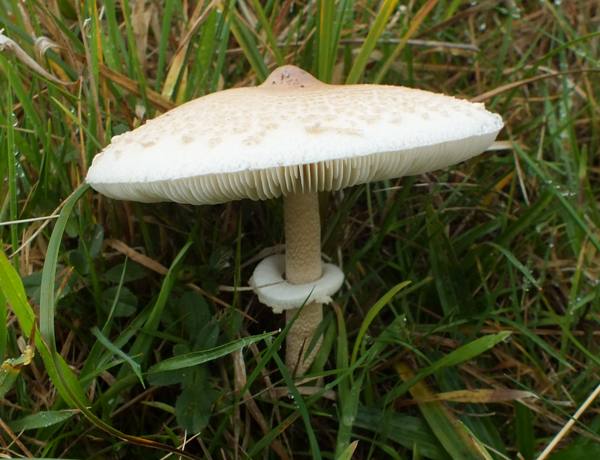
Macrolepiota mastoidea, the Slender Parasol, favours calcareous woodlands and grasslands. These large mushrooms also occur in coastal dunes in what would otherwise be acidic areas where it not for the presence of broken sea shells that raise the alkalinity of the thin soil. In some dune systems Slender Parasols appear in crowds.
Distribution
Slender Parasols are fairly common in Britain and Ireland; they also occur across most of Europe.
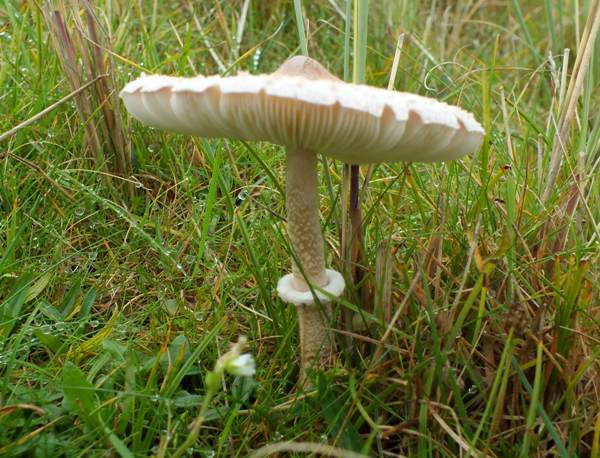
Taxonomic history
The basionym (base name) of this mushroom dates from 1821, when Elias Magnus Fries included it in his Systema Mycologia, calling it Agaricus mastoideus.
Earlier, in 1801, Danish botanist Heinrich Christian Friedrich Schumacher (1757 - 1830) had illustrated this mushroom, calling it Agaricus umbonatus. (In the early days of fungal taxonomy, almost anything with gills was placed in a gigantic Agaricus genus, now slimmed down to more manageable proportions as many of its former residents have been moved into more appropriate accommodation in new genera.)
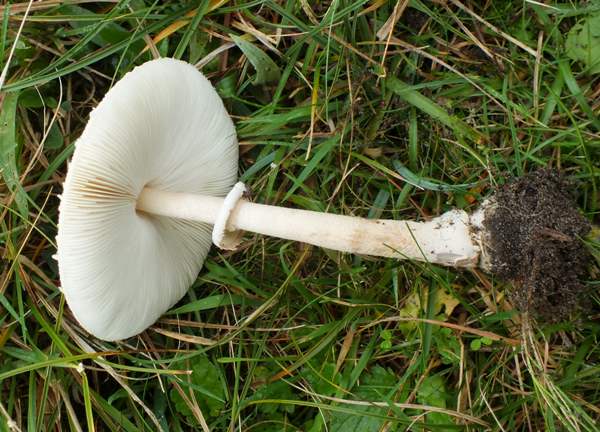
Synonyms of Macrolepiota mastoidea include Agaricus mastoideus Fr., Agaricus gracilentus Krombh., Lepiota mastoidea (Fr.) P. Kumm., Lepiota gracilenta (Krombh.) Quél., Lepiota umbonata (Schumach.) J. Schröt., Lepiota rickenii Velen., Macrolepiota gracilenta (Krombh.) Wasser, and Macrolepiota rickenii (Velen.) Bellù & Lanzoni.
Etymology
The specific epithet mastoidea is probably not a reference not to the bony prominence (mastoid) located behind the human ear but rather based on the prefix masto- meaning something to do with a woman's breasts and their nipples. These short-lived mushrooms (see picture above) are surely no long-term substitute for the real thing.
Identification guide
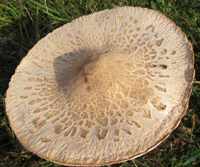 |
Cap
Initially spherical and pale brown with a
darker brown area near the crown that breaks into scales, the cap
expands until it is flat with a small umbo. The flesh of this mushroom gradually turns brown but does not redden noticeably when cut or bruised.
The cap diameter at maturity ranges between 5 and 15cm. |
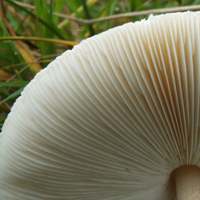 |
Gills
The broad, crowded gills, some of which fork, are white or pale
cream and free, terminating a small distance from the stipe. |
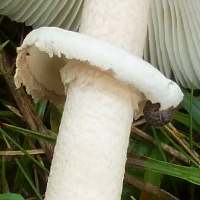 |
Stem
A double ring, the upper face pale and the lower face brown, usually persists around the stem
but often becomes movable and occasionally falls to the base. The stem surface is white and is covered with small, closely spaced yellowish-brown scales. Slightly bulbous at the base, the stem tapers inwards towards the apex; its
diameter ranges from 0.6 to 1.5cm, and the height varies between 6 and 16cm. |
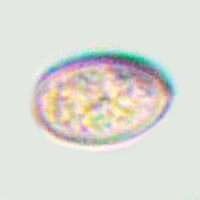 |
Spores
Ellipsoidal, smooth, 13-16 x 8-9.5µm; with a germ pore; dextrinoid.
Spore print
White or pale cream. |
Odour/taste |
Odour slight, 'mushroomy'; taste mild but not distinctive. |
Habitat & Ecological role |
Saprobic, in woodland clearings and in grassy areas
next to woodland; also on calcareous sand dunes. |
Season |
July to November in Britain and Ireland; later in the year in southern Europe. |
Similar species |
Macrolepiota procera, the Parasol, is larger and has a snakeskin-like pattern on its stem.
Chlorophyllum rhacodes,
the Shaggy Parasol, has reflexed scales and
a smooth stipe; its flesh reddens when cut or bruised. |
Culinary Notes
The Slender Parasol is a good edible species, but if you do gather these mushrooms to eat then please be aware that the somewhat similar Shaggy Parasol Chlorophyllum rhacodes is a toxic toadstool and can cause very serious stomach upsets. For advice on preparation and cooking these kinds of fungi see the culinary notes under Parasol, Macrolepiota procera.
Reference Sources
Fascinated by Fungi, 2nd Edition, Pat O'Reilly 2016, reprinted by Coch-y-bonddu Books in 2022.
BMS List of English Names for Fungi
Dictionary of the Fungi; Paul M. Kirk, Paul F. Cannon, David W. Minter and J. A. Stalpers; CABI, 2008
Taxonomic history and synonym information on these pages is drawn from many sources but in particular from the British Mycological Society's GB Checklist of Fungi.
Top of page...
Fascinated by Fungi. Back by popular demand, Pat O'Reilly's best-selling 450-page hardback book is available now. The latest second edition was republished with a sparkling new cover design in September 2022 by Coch-y-Bonddu Books. Full details and copies are available from the publisher's online bookshop...